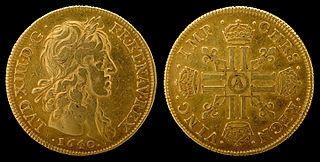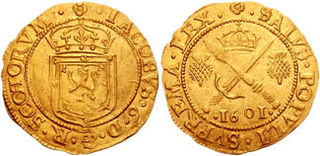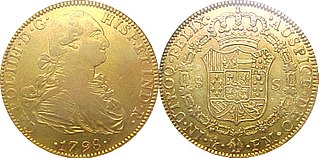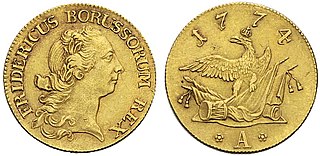Related Research Articles

The standard circulating coinage of the United Kingdom, British Crown Dependencies and British Overseas Territories is denominated in pounds sterling, and, since the introduction of the two-pound coin in 1994, ranges in value from one penny to two pounds. Since decimalisation, on 15 February 1971, the pound has been divided into 100 (new) pence. Before decimalisation, twelve pence made a shilling, and twenty shillings made a pound. British coins are minted by the Royal Mint in Llantrisant, Wales. The Royal Mint also commissions the coins' designs.

A penny is a coin or a unit of currency in various countries. Borrowed from the Carolingian denarius, it is usually the smallest denomination within a currency system. Presently, it is the formal name of the British penny (abbr. p) and the informal name of the American one cent coin (abbr. ¢) as well as the informal Irish designation of the 1 cent euro coin (abbr. c). It is the informal name of the cent unit of account in Canada, although one cent coins are no longer minted there. The name is also used in reference to various historical currencies also derived from the Carolingian system, such as the French denier and the German pfennig. It may also be informally used to refer to any similar smallest-denomination coin, such as the euro cent or Chinese fen.

The guinea was a coin, minted in Great Britain between 1663 and 1814, that contained approximately one-quarter of an ounce of gold. The name came from the Guinea region in West Africa, where much of the gold used to make the coins originated. It was the first English machine-struck gold coin, originally worth one pound sterling, equal to twenty shillings, but rises in the price of gold relative to silver caused the value of the guinea to increase, at times to as high as thirty shillings. From 1717 to 1816, its value was officially fixed at twenty-one shillings.

The sovereign is a gold coin of the United Kingdom, with a nominal value of one pound sterling. Struck from 1817 until the present time, it was originally a circulating coin accepted in Britain and elsewhere in the world; it is now a bullion coin and is sometimes mounted in jewellery. In most recent years, it has borne the design of Saint George and the Dragon on the reverse; the initials of the designer, Benedetto Pistrucci, are visible to the right of the date.

The Royal Mint is a government-owned mint that produces coins for the United Kingdom. Operating under the name Royal Mint Ltd, the mint is a limited company that is wholly owned by Her Majesty's Treasury and is under an exclusive contract to supply all the nation's coinage. As well as minting circulating coins for use domestically and internationally, the mint also produces planchets, commemorative coins, various types of medals and precious metal bullion. The mint exports to an average of 60 countries a year, making up 70% of its total sales. Formed over 1,100 years ago, the mint was historically part of a series of mints that became centralised to produce coins for the Kingdom of England, all of Great Britain and eventually most of the British Empire. The original London mint from which the Royal Mint is the successor was established in 886 AD and operated within the Tower of London for approximately 800 years before moving to what is now called Royal Mint Court where it remained until the 1960s. As Britain followed the rest of the world in decimalising its currency, the Mint moved from London to a new 38 acres (15 ha) plant in Llantrisant, Glamorgan, Wales, where it has remained since.

The Louis d'or is any number of French coins first introduced by Louis XIII in 1640. The name derives from the depiction of the portrait of King Louis on one side of the coin; the French royal coat of arms is on the reverse. The coin was replaced by the French franc at the time of the revolution and later the similarly valued Napoléon. The actual value of the coins fluctuated according to monetary and fiscal policy, but in 1726 the value was stabilized.
The livre tournois, French for the "Tours pound", was:

The Coinage Act or the Mint Act, passed by the United States Congress on April 2, 1792, created the United States dollar as the country's standard unit of money, established the United States Mint, and regulated the coinage of the United States. The long title of the legislation is An act establishing a mint, and regulating the Coins of the United States. This act established the silver dollar as the unit of money in the United States, declared it to be lawful tender, and created a decimal system for U.S. currency.

The pound Scots was the unit of currency in the Kingdom of Scotland before the kingdom unified with the Kingdom of England in 1707. It was introduced by David I, in the 12th century, on the model of English and French money, divided into 20 shillings, each of 12 pence. The Scottish currency was later debased relative to sterling and, by the time of James III, the pound sterling was valued at four pounds Scots.

The doubloon was a two-escudo or 32-real gold coin, weighing 6.867 grams in 1537, and 6.766 grams from 1728, of .917 fine gold. Doubloons were minted in Spain and the viceroyalties of New Spain, Peru, and Nueva Granada. The term was first used to describe the golden excelente either because of its value of two ducats or because of the double portrait of Ferdinand and Isabella.

Pistole is the French name given to a Spanish gold coin in use from 1537; it was a double escudo, the gold unit. The name was also given to the Louis d'Or of Louis XIII of France, and to other European gold coins of about the value of the Spanish coin. One pistole was worth approximately ten livres or three écus, but higher figures are also seen. The derivation is uncertain; the term may come from the Czech píšťala, or from the Italian town of Pistoia; either way, it was originally spelled pistolet and originated in military slang, and probably has the same root as pistol.
From c. 1124 until 1709 the coinage of Scotland was unique, and minted locally. A wide variety of coins, such as the plack, bodle, bawbee, dollar and ryal were produced over that time. For trading purposes coins of Northumbria and various other places had been used before that time; and since 1709 those of the Kingdom of Great Britain, and then of the UK.
The Thaler was the currency of the Free Hanseatic City of Bremen until 1873. It was divided into 72 Grote, each of 5 Schwaren.

The three-dollar piece was a gold coin produced by the United States Bureau of the Mint from 1854 to 1889. Authorized by the Act of February 21, 1853, the coin was designed by Mint Chief Engraver James B. Longacre. The obverse bears a representation of Lady Liberty wearing a headdress of a Native American princess and the reverse a wreath of corn, wheat, cotton, and tobacco.
This article provides an outline of the currency of Spanish America from Spanish colonization in the 15th century until Spanish American independencies in the 19th. This great realm was divided into the Viceroyalty of New Spain, which came to include all Spanish territory north of Panama, the West Indies, Venezuela, and the Philippines, and the Viceroyalty of Peru, which included Panama and all Spanish territory in South America except Venezuela. The monetary system of Spanish America, originally identical to that of Spain, soon diverged and took on a distinctive character of its own, which it passed on to the independent nations that followed after.

The Friedrich d'or was a Prussian gold coin (pistole) nominally worth 5 silver Prussian Reichsthalers. It was used from 1741 to 1855 and since it was a silver standard regular issue coin and trade coin at this time, it had a different purpose to domestic silver coinage or Kurantgeld, the so-called window on the stock exchanges. It was normally traded at a small premium or discount to the face value of 5 thalers. In Prussian purchase contracts or bonds it was, due to its monetary usage, distinguished as the "preußisch Courant" or "Friedrich d'or".

The Great Debasement (1544–1551) was a currency debasement policy introduced in 1544 England under the order of Henry VIII which saw the amount of precious metal in gold and silver coins reduced and in some cases replaced entirely with cheaper base metals such as copper. Overspending by Henry VIII to pay for his lavish lifestyle and to fund foreign wars with France and Scotland are cited as reasons for the policy's introduction. The main aim of the policy was to increase revenue for the Crown at the cost of taxpayers through savings in currency production with less bullion being required to mint new coins. During debasement gold standards dropped from the previous standard of 23 carat to as low as 20 carat while silver was reduced from 92.5% sterling silver to just 25%. Revoked in 1551 by Edward VI, the policy's economic effects continued for many years until 1560 when all debased currency was removed from circulation.

The Louisiana Purchase Exposition gold dollar is a commemorative coin issue dated 1903. Struck in two varieties, the coins were designed by United States Bureau of the Mint Chief Engraver Charles E. Barber. The pieces were issued to commemorate the Louisiana Purchase Exposition held in 1904 in St. Louis; one variety depicted former president Thomas Jefferson, and the other, the recently assassinated president William McKinley. Although not the first American commemorative coins, they were the first in gold.
A Half-pistole was a Scottish gold coin minted in 1701 under the reign of King William III. Along with the Pistole it was one of last gold coin minted for the Kingdom of Scotland before the Acts of Union 1707. The Half-pistole was equal to 6 Scottish pounds with an approximate value equal to the British Half guinea.
References
- ↑ "Scottish Coins". predecimal.com. Retrieved 13 July 2017.
- ↑ Whitelaw, Alexander (1846). The popular encyclopedia; or, 'Conversations Lexicon': [ed. by A. Whitelaw from the Encyclopedia Americana. Glasgow: Blackie & Sons. p. 279.
- ↑ Pantologia: A New Cabinet Cyclopaedia. London. 1819. p. 457.
| This coin-related article is a stub. You can help Wikipedia by expanding it. |
| This Scottish history-related article is a stub. You can help Wikipedia by expanding it. |
